We here at Pitcher List feel fantasy baseball is a lifestyle, so we decided to do a couple of early mock drafts to get a feel for the drafting environment for 2020. As my first draft of the year, I was a little rusty but had a lot of fun drafting with a lot of Pitcher List writers and Discord supporters.
The league settings are pretty standard: 12-team, 5×5, head-to-head with four outfielders and two utility spots.
Check out the entire draft board here.
You can listen to Nick and I discuss my draft as well to get Nicks’s opinion on it (spoiler, it’s not good).
#TeamBounceback
1.09 – Gerrit Cole, SP (FA)
I tend to be pretty risk-averse when it comes to the first couple of rounds. I believe somewhat in the theory “you can’t win your draft in the first but you can lose it,” so this pick isn’t something I normally do. Gerrit Cole, however, made me change my mind. Taking the first pitcher off the board worries me a touch, but he’s far and away ahead of the rest that I love this pick. Cole last year set records (legit the best season ever) for strikeout percentage (39.9%) and K/9 (13.8), and unless he goes to Coors, he should continue his dominance. A 0.89 WHIP and 2.50 ERA seem unreliable to expect for next year, but his underlying numbers backed it up. Trevor Story and Francisco Lindor were my top choices here, but I am thrilled to have Cole on my team.
2.16 – Jose Ramirez, 3B (CLE)
So what was that about being risk-averse? Jose Ramirez was one of, if not the, worst hitters from the second half of ’18 to mid-June of ’19. People feared he was done. MVP Ramirez was no more. Why oh why was he hitting under the Mendoza line when he had so much talent? It’s quite possible it was from trying to go the opposite way. Take a look at this graph and tell me what sticks out to you:
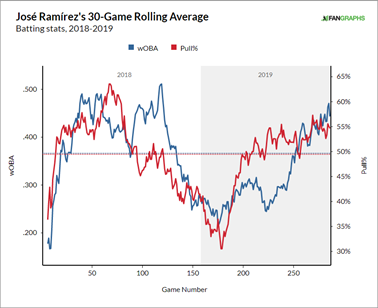
Ramirez is much, much, much better when he pulls the ball. From June 21 onward, he slashed .325/.371/.703 and added seven stolen bases during that stretch. He feels like a safe 30/20 candidate with a .290+ average, and I will take that in the second. J.D. Martinez was in consideration here, but I wanted the stolen bases. I also gambled someone I like just as much as JDM would be available at my next pick…
3.33 – Yordan Alvarez, UTIL (HOU)
After moving Yordan Alvarez in my dynasty league literally one week before he got called up, I will be taking as much Alvarez I can. Especially if I can get him any time in the third. Alvarez was a monster in his limited time in the majors and put up an asinine 178 wRC+ in 369 plate appearances. While I don’t think he’ll repeat that next year, according to Statcast, his xSLG was in the 98th percentile (.602 xSLG!!!!!), so he can clearly mash the ball. His xwOBA, Hard-hit %, EV and xBA were also all elite and should help Alvarez put up a 35+ home run season in 2020 if he stays healthy. I had no backup plan here, so I’m very glad no one snagged Alvarez from me, but looking it over I would have settled for boring ‘ol Charlie Blackmon.
4.40 – Chris Sale, SP (BOS)
Starting pitching seems to be going a lot later than I expected it to. Chris Sale in the fourth seems like amazing value, but when you look and see Blake Snell, Aaron Nola, Luis Castillo and Clayton Kershaw all go later, I’m not really sure anymore. Sale seems like an obvious bounce-back candidate for me going into 2020, as he posted an elevated BABIP (.306) and dreadful LOB% (66.7%). His fastball is a slight concern, as it lost velocity for the second year in a row and posted the worst pVAL in the last six years (0.4), but he still has an elite slider he started leaning on more last year. Even with that concern, when the IP limit is lowered to 140, Sale has the second-best K% of qualified SP, and his WHIP was still elite at 1.09. I will gladly take Sale as my second SP. Blackmon probably would have been the better pick, as outfielders thin out quick, but I felt I wouldn’t have to worry about SP as much with Sale (I was wrong).
5.57 – Keston Hiura, 2B (MIL)
Keston Hiura is 100% bat, and I am drinking the Kool-Aid. From the second base position, I am a big fan, even despite his strikeout concerns in the majors. In his small major-league debut he, much like Yordan Alvarez, mashed taters to the tune of 90th percentile exit-velocity (91.4 MPH) and 97th percentile hard-hit percentage (50% of his batted-ball events were classified as hard). Unlike Alvarez, however, was his inability to make contact. Hiura ranked 265th out of 273rd in contact % last year (min. 300 plate appearances), showcasing his struggles, which is odd as he’s often been scouted having a potential 60-grade hit-tool. It’s quite possible he made the decision to sell-out for power last year, as even in AAA he had an elevated strikeout rate with amazing power numbers. If he can cut that strikeout rate to even 25% I see a star in the making, being able to hit 25+ home-run with 20 stolen-base potential. My one regret here is not taking Ozzie Albies, as he would have helped fill-out my stolen bases a lot better than Huira without the strikeout downside.
6.64 – Gary Sanchez, C (NYY)
Something I noticed about this draft was later on a TON of catchers I’m intrigued by went fairly late (Carson Kelly 258th, Travis d’Arnaud 268th, Salvador Perez 273rd). Even with my intrigue, I think I still prefer taking a catcher sooner than later. Pitcher List’s own Collin Charles posted a tweet showcasing that getting a top catcher (✔️), shortstop (✔️) and center-fielder (❌) can make the difference for your fantasy team and I believe it.
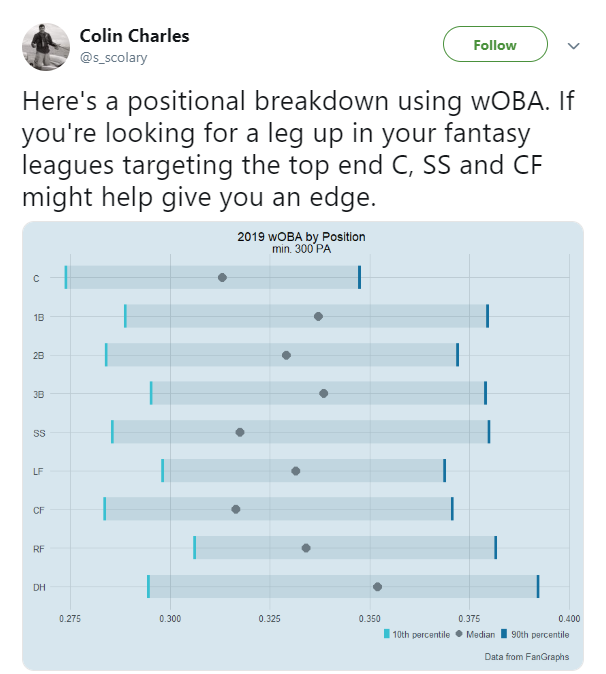
So after J.T. Realmuto went three picks earlier, I knew I had to act fast. Gary Sanchez was my catcher target as I really do enjoy having to set and forget my catcher and not worry about streaming. He’s the only catcher I view with true 40+ home run potential and should get some DH at-bats, helping pad his stats. He seemingly put his woeful ’18 season behind him last year increasing his hard-hit%, flyball% and lowering his pop-up%, which was a killer in ’18. My team is looking quite good in home-runs so far.
7.81 – Rhys Hoskins, 1B (PHI)
Guys that hit a ton of pulled fly-balls for home-runs butter my biscuits. Rhys Hoskin’s only issue is he hit too many poor fly-balls. PL’s Nick Gerli noticed the trend from the first half while Kyle Horton went in-depth to talk about these struggles. I do believe he just needs to continue to pull the ball, as he seems it’s when he has the most success rather than trying to go the opposite field (much like Jose Ramirez).
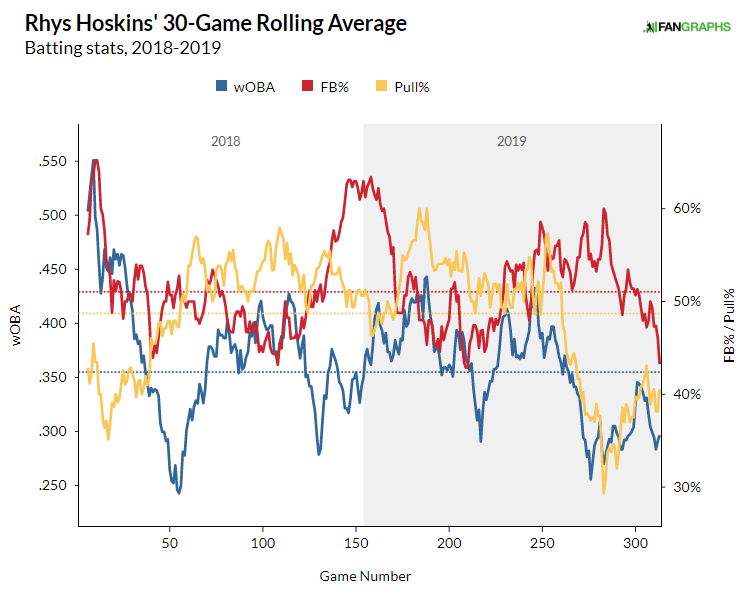
First base seems to get quite mediocre after Carlos Santana (who I do actually prefer where he was taken in the 9th) and I really do like Hoskins’ skills. 40 home runs are certainly possible every year with him, and his patience should help him get into counts that will help. Nelson Cruz would have been my go-to pick here if it wasn’t for Yordan Alvarez and not wanting to fill both UTIL spots early. I’ll regret that.
8.88 – Carlos Correa, SS (HOU)
Easily my favourite pick of the draft. I had been considering Carlos Correa since the 5th round but kept waiting with the other shortstops still available. Bo Bichette would end up going two picks earlier, but I think I would MUCH rather have Correa. Last year was amazing for Correa when he was healthy, as he rose his line-drive %, fly-ball %, barrel %, launch angle… all things that lead to great success. The biggest issue with him is that he’s now dealt with multiple injuries while being in the majors, only playing more than 110 games ONCE in the last five years. I had planned to take a backup shortstop later on in the draft but didn’t need to as there were many guys that would be available on waivers after the draft had ended (Willy Adames, Andrelton Simmons, DansBAE Swanson, Didi Gregorius), making this pick much better.
9.104 – Yasiel Puig, OF (FA)
I probably waited too long on my outfield, but that doesn’t mean Yasiel Puig isn’t a good one. #PuigYourFriend is a year-to-year 20/20 candidate and in ’19 he was super close, with 24 home runs and 19 stolen bases between the Cincinnati Reds and Cleveland Indians. He also can provide 150 RBI+R when healthy, but has rarely been, as he’s dealt with a ton of injuries in his past. It was a weird year for him honestly, as with the Reds, he didn’t walk at all and with the Indians, he didn’t hit for power. He did hit for a better exit-velocity, walk-rate and hard-hit rate with the Indians, but more ground-balls. My gut tells me he stays with the Indians, as they have approximately one and a half good outfielders and he seemed to really enjoy his time there.
10.111 – Trevor Bauer, SP (CIN)
Trevor Bauer was the best starter available in my opinion, but my real target was his teammate Sonny Gray, who went three picks before. Purely taken as an upside pick, Bauer was fairly awful last year with the Indians and Reds, sporting a 4.48 ERA (and subsequent underwhelming 4.34 FIP) but did suffer from some bad luck (60% LOB%, .315 BABIP with the Reds). On the bright side, Bauer did strikeout 27.8% of batters, which was good for 18th in the MLB (and had the same K:BB% as Luis Castillo) but that still was a stern drop-off from ’18. I do think a full offseason with Reds pitching guru Derek Johnson could help, along with getting to spend some sessions with his Driveline friend Kyle Boddy. Nothing to back that up, but I really believe Bauer can return to top-5 pitcher upside like he was in ’18. I probably should have gone with Zack Wheeler here, as he would have been an ERA and WHIP stabilizer and I don’t think I needed the strikeout help.
11.128 – Edwin Diaz, RP (NYM)
Looking at my draft so far, I may end up struggling in ERA and WHIP. Oh well! Edwin Diaz to me is one of the last elite closers available, even with his bad ’19 season, as he was somewhat unlucky last year. I don’t care who you are, a .377 BABIP probably isn’t going to repeat itself even with the amount of bad contact he was giving up (2nd percentile hard-hit %). The slider wasn’t as good last year as in ’18 as he wasn’t locating it as well. It was an elite pitch still, but also got crushed (90.7 average EV).
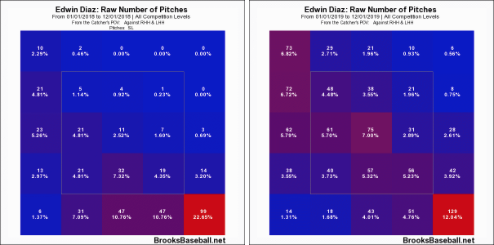
Looking back, Ken Giles would have been probably the safer play, but doesn’t have the saves potential I view Diaz having. Also over his last 22 appearances over 18 innings he struck out 38 (48.7 K%) of 78 batters faced (Thanks Matt Modica for that stat).
12.135 – Nick Senzel, OF (CIN)
Great American Ballpark is a fantastic place to hit and I expect big things from Nick Senzel next year. While he isn’t someone that’s going to hit 20+ home runs, his line-drive profile and elite stat-cast speed (96th speed percentile) will help him prop up a higher average and should be a 20/20 threat. His strikeout rate was a tad high in ’19 in his first MLB stint but hoping it will regress down to his minor-league average of 20%. Injuries are a concern with Senzel as he has dealt with some major issues (torn labrum, torn finger tendon, vertigo), but thankfully they’re not related or soft-tissue issues. I can also see him ending up with second-base or third-base eligibility if Eugenio Suarez or Josh Van Meter (if he’s even the second-baseman) and that’s always handy to have.
13.152 – Luke Weaver, SP (ARI)
More risk! I really went high risk / high reward in this draft and Luke Weaver is no different. If not for right forearm tightness, Weaver might be going upwards to 60 picks earlier, as in his brief ’19 season, he was amazing. Elite control and rediscovering his cutter (which helps him vs righties) helped him put up a 2.97 ERA, 3.01 FIP and 21.2% K:BB %. While the humidor more than likely helped some of the fly balls from becoming home runs (37.8% fly-ball%) his almost 5:1 K:BB will help mitigate any regression. With his curveball becoming average to decent he has four pitches to work with now and that will help the change and fastball play up. He honestly might be my second best ERA pitcher and that’s scary.
14.159 – Khris Davis, UTIL (OAK)
My second favourite pick of the draft, Khrush Davis, was awful last year. It can somewhat be attributed to a wrist injury he dealt with most of the year. He himself said it was impacting him:
“It’s just not as strong as it should be. I’ve been choking up a little bit, and that’s been helping a little, but not a lot of power guys choke up.”
He also struggled against fastballs last year, which could be attributed to having to modify his swing. In ’19 he slugged .405 against them, while in ’18 it was a elite .696 SLG. Before last year Davis was a lock for a .247 AVG and a butt-ton of home runs. While that is somewhat of an average-drain, I do think I’ve got enough average so far I can take that hit. 40+ home runs is possible along with 180+ R+RBI if he bounces back to previous years levels. It’s quite possible he’s going to decline thanks to age, and if he’s still bad his is late enough, I could drop him a month or two into the season and not feel bad about it.
15.176 – Kenta Maeda, SP (LAD)
Kenta Maeda has been safely reliable the last couple of years and in my eyes, and continues to be drafted at a discounted rate. Arguably the best pitcher value I’ve drafted, Maeda finished last year as the 30th SP on ESPN’s Player Rater and I got him as the 54th SP. With the Los Angeles Dodgers potentially having openings in their rotation with Hyun-Jin Ryu and Rich Hill being free agents, Maeda should be penciled in for his 140-160 IP the Dodgers seem to give him every year. Maeda was elite at allowing soft-contact in ’19, with elite exit-velocities, hard-hit %, xSLG and xBA helping him have a .243 BABIP.
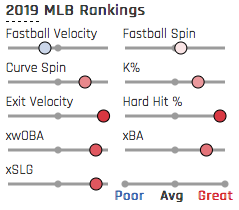
While that’s sure to regress, he also had the second best strikeout percentage of his career with a 27.1% strikeout rate. He started throwing his changeup and slider more, arguably his two best pitches, to much success. Mitch Haniger would end up going three picks later (man, Colin Charles sniped me A TON) who was my target coming back around, so I probably should have snagged him and waited on Maeda.
16.183 – Craig Kimbrel, RP (CHI)
#TeamBounceBack full steam ahead! Craig Kimbrel was horrible last year (sense a theme here yet?) but I’m going to attribute it some of it to not being signed until June 7th, really messing up his year. After signing, he had little time in the minors with the Chicago Cubs in the playoff hunt and didn’t get a Spring Training. His fastball declined for the second year in a row, losing another mile off of it and showcasing poor control all year with it. He also gave up A TON of hard contact with it, allowing a barrel rate of 21.2% and xSLG of .731.
So why did I draft him? Well, I do believe he’s going to have a long-is leash with the Cubs. They realize he was rusty last year and it was more than likely just a small sample size issue. Their bullpen has been a mess for a couple of years now and no one other than Kimbrel really sticks out as closer candidates. He might have to end up leaning on his curveball more, as it’s still an elite pitch, and it would help him limit the damage the fastball could do.
17.200 – Aaron Hicks, OF (NYY)
Firstly, this pick was made before the Tommy John surgery for Aaron Hicks was announced, which made him essentially undraftable in 12-team leagues, as he will be out for a while. Secondly, this pick over Andrew McCutchen was a BIG mistake. I do however like Hicks when healthy, as he’s showed the ability to hit for power while adding 10ish steals. Injuries have been an issue for Hicks and last year his elbow strain (that would require TJ) was the cause. When he was healthy though he was able to score 41 runs and 36 RBI in only 221 PA, so I was banking on him being able to contribute in all categories thanks to batting 2nd or 3rd in the dangerous Yankees lineup. This is the one pick I really regret.
18.207 – Joe Musgrove, SP (PIT)
I ended up taking another starter here, as Nick Anderson was really my target as I think he can grab some saves with elite strikeouts, ERA, WHIP, etc. Still, Joe Musgrove is a very good starter to get this late. His season was a wild rollercoaster, as evident by the table below:
| Month | ERA | FIP | K:BB% | BABIP |
| March/April | 1.54 | 2.59 | 17.8% | .245 |
| May | 8.10 | 4.91 | 5.7% | .330 |
| June | 3.51 | 3.53 | 18.3% | .333 |
| July | 4.11 | 5.53 | 18.3% | .215 |
| August | 6.27 | 3.97 | 18.1% | .354 |
| September/October | 2.25 | 1.34 | 26.6% | .308 |
A lot is going on there, including months where he was lights out and months where he was getting hit hard and often. One of his strongest suits is his K:BB%, as his 16.4% K:BB % was 30th of all SP. Musgrove features an elite slider that he upped this year from ’18 from 18% to 22%, getting a 19.5% swinging strike rate on it. It had more horizontal movement on it than his ’18 season as well, helping pave the 12% swinging strike rate overall. His 3.82 FIP and 63.2% LOB% make me think he’s got more to give, and hopefully, this year will be it.
19.224 – Anthony DeSclafani, SP (CIN)
I view Musgrove and Anthony DeSclafani somewhat similarly. Both will be drafted past 200, both of them are post-hype pitchers and both have featured an elite slider. Disco also had a fairly great K:BB rate, slotting in one spot ahead of Musgrove at 29th with a 17% rate. Disco’s ’19 season was one of his best, as he featured a velocity increase that helped him post one of his best eras (3.94) and increased strikeout rate (24%). His slider, unlike Musgrove’s though, took a step back this year (.341 xwOBA) and he even started using his curveball more to compensate. His curve was decent but was hit very hard when it was, giving up a .250 ISO with it. Great American Ballpark is a bad mix when you’re giving up a ton home runs (1.57 HR/9), but he did drop that from ’18, so hopefully, he can continue that trend.
20.231 – Wil Myers, OF (SDP)
Thanks to my ability not to read, I wasn’t aware this was a four outfielder league, not three, so, unfortunately, Wil Myers will be slotted into starting duty along with whatever waiver wire pickup I make for Aaron Hicks. Boy, my outfield is bad! I think Myers is interesting this year however, as his strikeout rate can’t possibly get any worse (was the worst in MLB with min. 450 PAs). Ben Clemens of FanGraphs wrote a piece back in July talking about Will Myers and noticed he wasn’t swinging at more pitches outside of the zone, but that he was swinging through pitches (13.6% swinging strike percentage in ’19 much higher than career norms). This feels like a change in approach, as he had everything you would want in a fly-ball revolution guy: more fly balls, barrel % shot up, his fly-ball EV was above league average. The strikeouts completely limited this approach, but it gives me hope it’s something he can work on and fix. He seems to be a safe bet to steal more than 10 bases (although, his 67% stolen base percentage isn’t amazing) while also hitting for power, and I’ll take the gamble this late #TeamBounceback.
21.248 – Tommy La Stella, 2B/3B (LAA)
I feel like everyone’s forgotten about Tommy La Stella. For the first couple of months, La Stella was playing as we had never seen before, slashing .295/.346/.486 with 16 home runs, good for a 122 wRC+. Then sadly he broke his leg, ending his season and allowing fantasy owners to grab him at a very discounted rate going into 2020. He was so good in ’19 thanks to a swing/stance change, allowing him to barrel the ball with more ease and cutting his strikeout rate by quite a bit (14.1% to 8.7%). His hard-hit % was up, barrel % and launch angle were all higher in ’19 making me believe it wasn’t just a fluke. He should get playing time as well, as he’s more than likely the Los Angeles Angels starting third baseman (unless they go hard after someone like Anthony Rendon). Should the Angels sign someone, he can play multiple positions and will more than likely get his fair share of at-bats.
22.255 – Seranthony Domínguez, RP (PHI)
Seranthony Domínguez will be one of my favourite reliever targets going into 2020, as I think its the perfect situation for him. The Philadelphia Phillies bullpen is quite shaky (Hector Neris blew six saves last year), Domínguez himself was hurt/mediocre, lowering his draft-day price and he’ll be going late enough that if he’s bad you can drop him sooner than later. While he was hurt in ’19 over the last two years, he’s showcased two important things pitchers want: an elite ground-ball rate (18th among relievers w/ 80 IP) and strikeout rate (25th among relievers w/ 80 IP). Hopefully, he’ll be fully healthy coming into 2020, but Tommy John still could be needed, as he dealt with an elbow strain in ’19 that knocked him out in June.
23.272 – Adrian Houser, SP (MIL)
Last but not least, another starter I probably shouldn’t have taken but I love with all of my heart. Adrian Houser was weird last year. He started in the minors, came up and pitched predominantly as a reliever, was sent back down out then back up out of necessity as a starter and was pretty friggin good for his final 12 starts (also puked on the mound). In his final 12 starts, he had a 3.42 FIP, 53.3% groundball rate and a 26.7% strikeout rate while showcasing an elite sinker. His sinker allowed an average launch angle of -4 and while it was his most used pitch, it wasn’t thrown a crazy amount (36.1%). He did sport a below-average swinging-strike percentage at 9.6% (league average was 11.2%) so I don’t know how repeatable his strikeout rate is, but he did only allow an xwOBA of .281 so he still can be a valuable pitcher.
Final Thoughts
It’s a good thing this was my first draft and it was only a mock, as I’m not really in love with my team. I think it has a ton of upside, but man does it has no floor. Dave Richards did end up having my favourite draft, as he was able to get three pitchers with Ace upside in the 5th round of later and because of that was able to stack up his bats early on. My favourite picks were Matt Chapman at 10.113 (he was better than his ’18 season and is being drafted later than his ADP in ’18), Danny Santana at 12.133 (earlier than other drafts I’ve seen but holy does he remind me of Javier Baez), Andrew McCutchen at 18.210 (injury helped drafters forget about him and was on pace to have a 20/20 season last year) and Keone Kela at 22.262 (should have been my pick instead of Sir Anthony, as he was stellar coming back and should have the job).
| Category I will be Elite In | Category I will be Middling but Have Upside In | Category I will be Lesser In |
| HR | WHIP | AVG |
| Ks | R | W |
| RBI | W | ERA |
| SAVES |
(Photo by Brian Rothmuller/Icon Sportswire)

